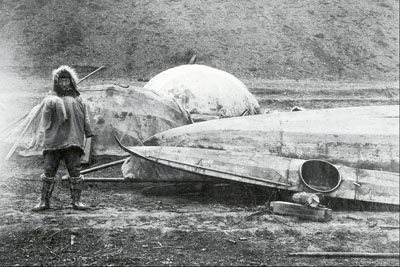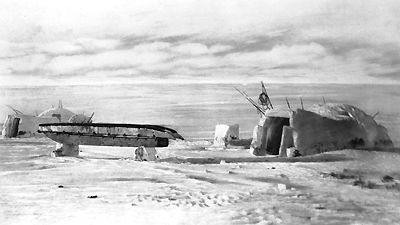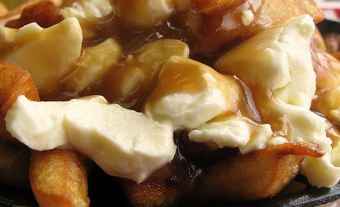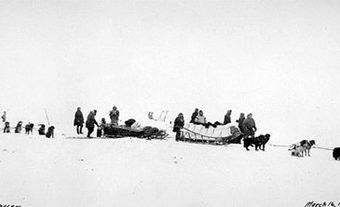How do you get from Poutine to the Canadian Arctic Expedition?
In this round of six degrees of Canadian history, we dig into a maudite poutine and end with the Canadian Arctic Expedition. A regional favourite with broad appeal, poutine is the closest thing Canada has to a national dish. A broad survey of a favourite region, the Canadian Arctic Expedition was the largest, most expensive and scientifically sophisticated Arctic venture of the early 1900s. But what does it have to do with poutine?
Well, it didn’t come with fries, but it did turn into a bit of a hot mess.
The following article is from our Six Degrees of Canadian History series. Past series are not updated.
Poutine
Poutine is a Canadian dish made of french fries topped with cheese curds and gravy. It first appeared in 1950s rural Québec snack bars and was widely popularized across Canada and beyond in the 1990s. Poutine may be found everywhere from fine dining menus at fancy restaurants to fast-food chains including McDonald’s and Burger King. It has become a symbol of Québécois and Canadian cuisine and culture.
The word poutine is commonly believed to have originated from the English word pudding (or as it were in French, pouding) used to describe a mixture, typically messy, of various foods. In Québec, the term poutine is slang for mess. More than a dozen other explanations have been offered, including the root of the French words potin (pâté) and poutitè (potato ragout).
A key ingredient in this signature Québec dish is cheese curds. And a signature cheese from Québec is the one that’s been made by Trappist monks in Oka for more than 150 years.
Oka
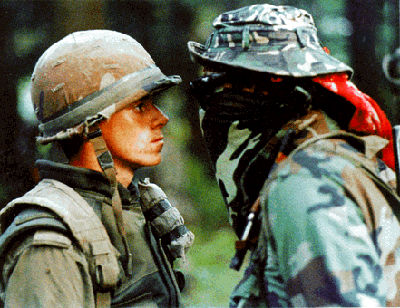
Oka, Québec, sits west of the Island of Montréal. The town was incorporated in 1875, six years before Trappist monks from France founded their famous Abbey of Notre-Dame-du-Lac, (now called Abbaye Val Notre-Dame, but best known as Oka Abbey).
Oka was the site of a 78-day standoff (11 July–26 September 1990) between Mohawk protesters, local police, and the Canadian Army (see Oka Crisis). At the heart of the crisis was the proposed expansion of a golf course and development of condominiums on disputed land that included a Mohawk burial ground. Tensions were high, particularly after the death of Corporal Marcel Lemay, a police officer. The situation was only resolved after the army was called in. While the golf course expansion was cancelled, and the land purchased by the federal government, it has still not been transferred to the Kanesatake community.
In one incident during the crisis, local residents stoned about 75 cars — containing mostly women, children and the elderly — as they tried to leave the Kahnawake reserve. That story is recounted in Alanis Obomsawin’s feature-length documentary Rocks at Whiskey Trench.
Alanis Obomsawin

One of Canada’s most distinguished documentary filmmakers, Alanis Obomsawin began her career as a professional singer and storyteller before joining the National Film Board in 1967. Her award-winning films address the struggles of Indigenous peoples in Canada from their perspective, giving prominence to voices that have long fallen on deaf ears. An Officer of the Order of Canada, she has received multiple Governor General’s Awards, lifetime achievement awards and honorary degrees.
Throat singing has figured in at least two of Obomsawin’s projects, including Mother of Many Children and Amisk. That style of singing has recently been popularized by Tanya Tagaq.
Tanya Tagaq

An experimental artist who has achieved a level of mainstream crossover success, Tanya Tagaq blends Inuit throat singing (traditionally done as a duet) with electronic, classical, punk and rock music. A Juno Award, Canadian Aboriginal Music Award and Polaris Music Prize winner, Tagaq is part of what CBC Radio’s Wab Kinew has called the “Indigenous Music Renaissance,” an innovative new generation of Indigenous artists in Canada. The New Yorker characterized her voice as, “guttural heaves, juddering howls and murderous shrieks,” and praised her work for its “fearless lack of inhibition, [its] technical skill and mastery of tradition.”
Speaking of her Inuit background, Tagaq has said: “I'm an Inuk woman, I think about what could be improved for my own daughter, my race. And that translates all the way up and back down into everything I do.”
Inuit
Inuit — Inuktitut for “the people” — are an Indigenous people, the majority of whom inhabit the northern regions of Canada. An Inuit person is known as an Inuk. The Inuit homeland is known as Inuit Nunangat, which refers to the land, water and ice contained in the Arctic region. The term Inuit Nunangat may also be used to refer to land occupied by the Inuit in Alaska and Greenland. In 2011, using data from the National Household Survey, Statistics Canada estimated that 59,440 people in Canada, about 4.2 per cent of the Indigenous population, identified themselves as Inuit.
In 2011, approximately 73 per cent of all Inuit in Canada lived in Inuit Nunangat, with nearly half living in Nunavut, followed by Nunavik (in northern Québec), Nunatsiavut (located along the northern coast of Labrador), and the western arctic (Northwest Territories and Yukon), known as Inuvialuit.
Inuit hunters, guides and seamstresses — such as Kohoktok and his wife Munnigorina, the hunter Avrunna, and Patsy Klengenberg — provided valuable support to the 1913 Canadian Arctic Expedition.
Canadian Arctic Expedition

The Canadian Arctic Expedition (1913–18) was Canada’s largest, most expensive and scientifically sophisticated Arctic venture to that date. It was the first expedition financed and supported by the Canadian government to venture into the Western Arctic. The expedition — which included many Inupiat, Inuvialuit and Inuinnait — asserted Canada’s sovereignty in the Arctic Archipelago, discovered new islands, remade the map of the Far North, and collected a vast amount of scientific data.
Commanded by the controversial explorer Vilhjalmur Stefansson and plagued by internal dissension, the expedition proved to be a mixture of achievement and disaster. It comprised more than 100 people, including scientist and second-in-command, Rudolph Martin Anderson, anthropologist Diamond Jenness, and dozens of Inupiat, Inuvialuit and Inuinnait hunters, guides and seamstresses. The expedition’s accomplishments included the discovery of Lougheed, Borden, Meighen and Brock Islands in the Arctic Archipelago, along with valuable scientific and cultural studies. However, its ship, the Karluk, was caught by ice off Alaska, and 11 men were lost.

 Share on Facebook
Share on Facebook Share on X
Share on X Share by Email
Share by Email Share on Google Classroom
Share on Google Classroom



